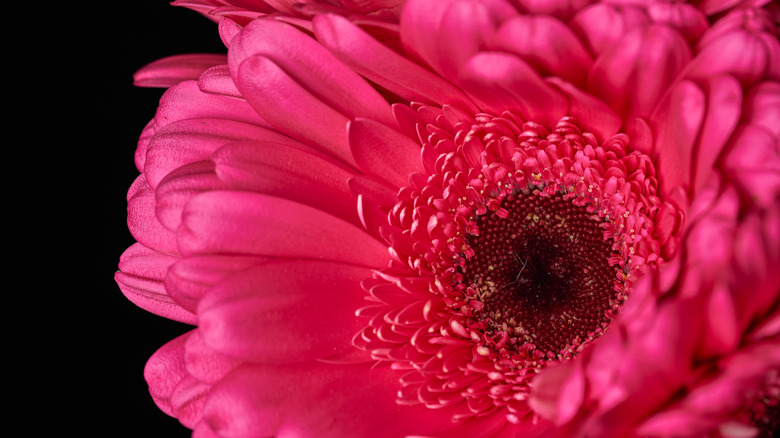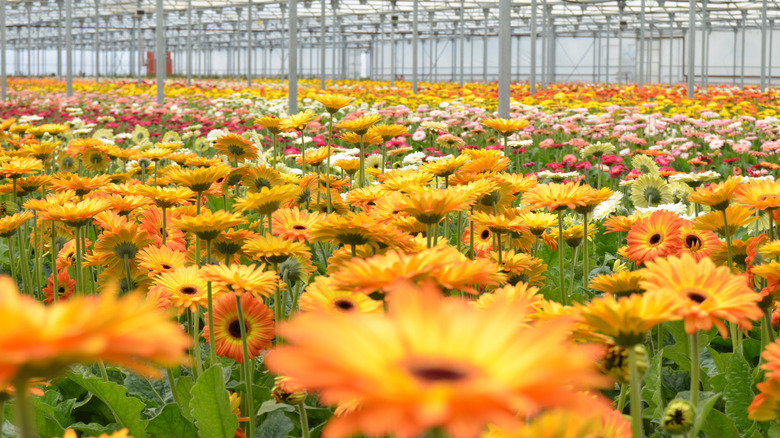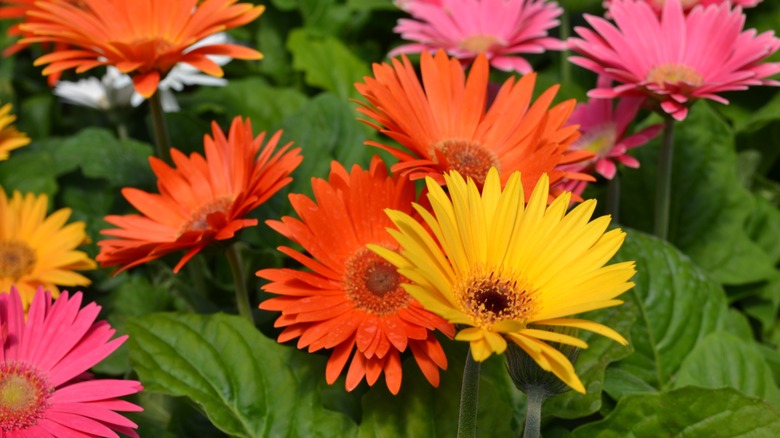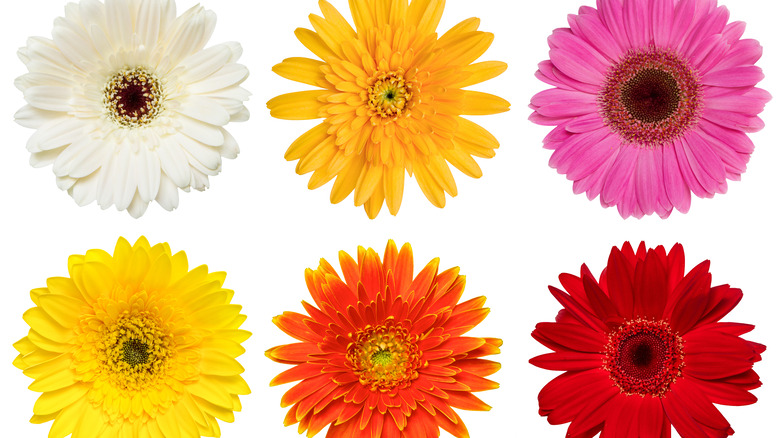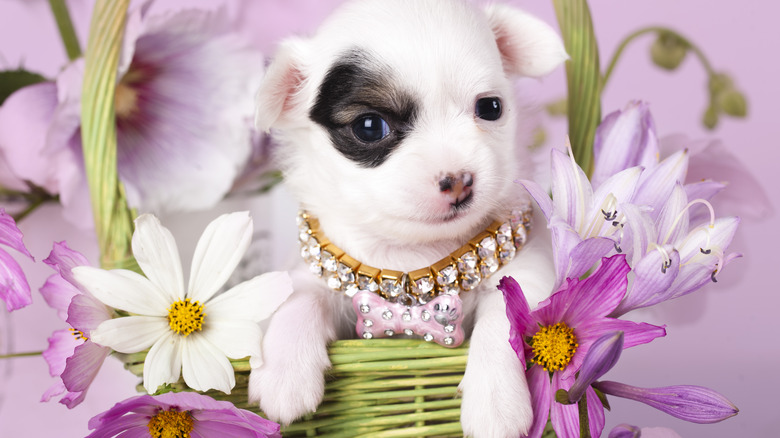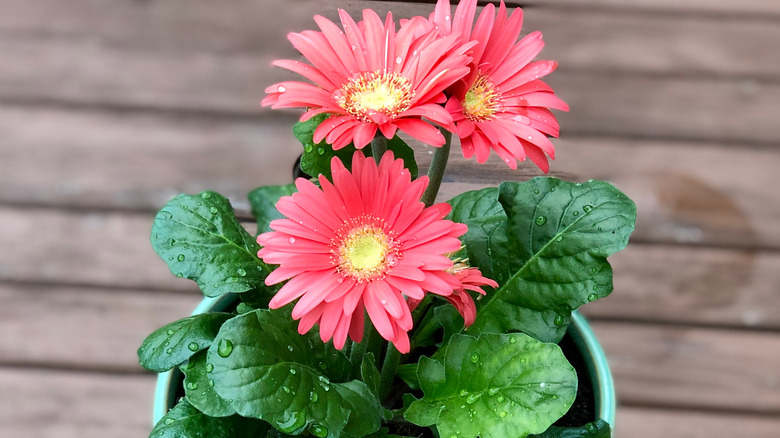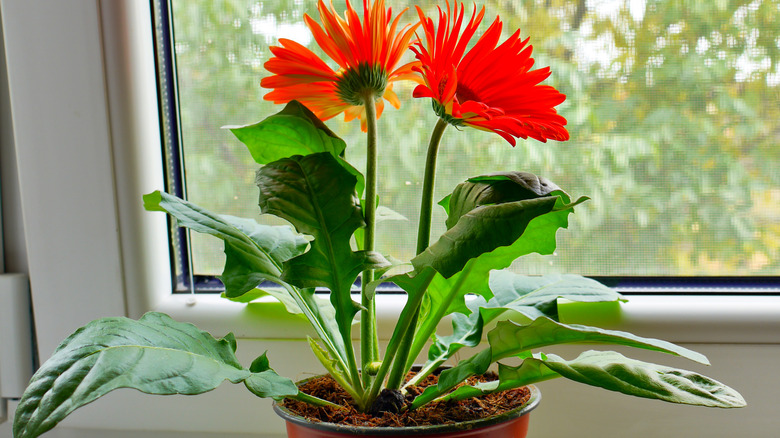Gerbera Daisies: Everything You Should Know Before Planting
If you want to grow a vivid, joyful garden with pink, yellow, orange, and other bright-colored blooms then the gerbera daisy (Gerbera jamesonii) is for you. The flowers come from South Africa and offer a range of sizes and colors, according to Gardening Know How. The site advises to select more compact plants — gerbera daisies from 2 to 5 inches — for pots and beds since the flower stems are stronger.
Named for Traugott Gerbera, the 18th-century naturalist, the plant belongs to the aster family, and is related to other sunny blossoms such as sunflowers and marigolds, according to the Home & Garden Information Center. Each daisy contains a pretty center that is colored in a range of hues, including yellows, bronzes, and blacks. Besides the full-colored petals, the flowers are sometimes bicolored and feature two hues. You can expect to see blooms from late spring to fall, and these blossoms work well as cut flowers and will retain their sweetness for several days.
While most areas grow these as annuals, warmer regions such as those in USDA hardiness zones 8 to 11 can raise them as perennials with care. Generally, they thrive in sunny areas and need just a bit of compost or occasional fertilizer. These easy-to-grown flowers will certainly brighten up any garden, too. Here's how to keep them happy and healthy.
How to grow gerbera daisies
You can grow gerbera daisies from starter plants or seeds. The key to healthy plants requires choosing the right ones from your nursery. Look for green foliage and any insects on the undersides — if you spot any aphids or whiteflies, select another plant. If you can easily remove the plant from its pot without dissembling the whole thing, glance at the roots; you want to see white vines, nothing brown or mushy, per Garden Gate Magazine.
Plant in the late spring. Use an area that offers lots of sunshine (six hours a day minimum) without too much heat. If you're in a tropical climate, ensure the plant gets some shade. Gerbera daisies like their soil well drained and slightly acidic (pH of 5.5 to 6.5). Allow some space — about 12 to 18 inches — between each one to encourage proper airflow and keep the crowns higher than soil level for optimal plant health. You want to water regularly as the plants root (via Garden Design).
With seeds, you can begin growing gerbera daisies indoors about 12 to 18 weeks before you plant. Using peat or paper pots will make transplanting easier and will disturb the roots less during the process. Rather than burying the seed, just press it into the dirt; light fosters germination. Cover with plastic wrap or a lid and place in a warm spot (about 70 degrees F) and seedlings should sprout in two to four weeks, according to The Spruce.
How to care for gerbera daisies
Two of the gerbera daisies' favorite things are well-drained soil and sunlight, so make sure you always provide that since the plant can get fungal disease fairly easily. This will coat the leaves and flowers with a white, powdery like covering. So do not over water these plants and try to avoid wetting the leaves. Watering in the morning also gives the plant time to dry and helps avoid rot. A once-a-week watering with a soaker hose will keep the roots saturated without wetting leaves. If you place mulch around it, make sure that the crown is not buried by it because these daisies like their air, as noted by Plant Care Today.
Enrich the plants monthly with an all-purpose fertilizer. If you're the forgetful type, you can also opt for a time-release version, which is only needed every six to eight weeks. Try to deadhead flowers when they wilt; this will stop the daisies from releasing seeds too early and keep fresh blossoms coming. Just remove the bloom and its stem up to the point you see another stem, bud or leaf (via SF Gate). If you are growing the plant indoors keep it near a window, but not too close. The daisies may like the sun but a surplus of direct light often wilts or burns them, according to Den Garden.
Varieties of gerbera daisies
There are upwards of 40 varieties of this plant and you can expect to see them in lots of hues, from bright oranges, yellows, and reds to pretty pastels like pink, said Country Living. They come in four main flower types: single, double, crested double, and full crested double. Single is just like it sounds — one middle green disk surrounded by petals that don't overlap. It is the most common variety. Doubles have two rows of overlapping petals, and the center disks can be green, black or dark red. Crested doubles have the same characteristics as the plain double, and also features an inner row (sometimes two) of smaller petals. Full crested has two rows of inner and outer petals (from Petal Republic).
- Woman Gerbera Daisy has bright pink petals with a fluffy-looking center.
- Sombrero Gerbera offers a deep red flower with a dark purple, almost black center.
- Revolution Red Gerbera Daisy blooms earlier than many other varieties and its red blooms can grow up to 10 inches (via Better Homes & Gardens).
- Orange Spider Daisy has bold orange petals more like spikes and an orange/yellow core; this daisy can be as high as 1 foot.
- Gerbera White has clean white petals and an ivory/yellow center; these plants look great in a bed or container and can grow up to a foot high, as per Home Stratosphere.
Are gerbera daisies toxic?
Gerbera daisies are appealing in so many ways; they are bright and cheery and work beautifully in containers, flowerbeds, and in arrangements. They are also non-toxic to your furry friends, according to Pet MD.
But you should be careful if you are a daisy fan. While gerbera varieties offer pets no harm, they do belong to the aster plant family, which includes other daisy relatives that are poisonous. Some of these are chrysanthemums or mums, which possess sesquiterpene, lactones, and pyrethrins — all toxic to cats, horses, and pooches. If an animal eats this type of daisy they may have a variety of symptoms, including vomiting, diarrhea, skin irrigation, excess saliva, and a loss of coordination. You should call ASPCA Animal Poison Control Center at 1-888-426-4435 ASAP if your pet eats these type of daisies.
So if you are a pet owner, be especially careful when purchasing daisies. Make sure that you are getting the gerbera kind, as it can be easy to make a mistake (via SF Gate).
How to repot gerbera daisies
Gerbera daisies with their pastel colors and lush leaves look wonderful in a flower pot. Whether you want to bring some of that vibrance indoors or just re-plant daisies that are outgrowing their container, re-potting this lovely flower is quite easy. The first step requires that you select a pot bigger than its current one. Good soil is also key to ensure that the daisies flower over and over, according to Nature & Garden. Your first layer in the pot should be some gravel or clay pebbles at the bottom to help drainage. Replanted daisies dislike too much water, so you want the soil moist, but never saturated. Make sure the H20 remains on the soil and not the leaves, too.
One great thing about putting gerbera daisies in pots is that you can move them as the seasons change. These flowers like lots of sunlight, but not temperatures over 70 degrees Fahrenheit, as noted by Birds and Blooms. Pots allow you to give the daisies the conditions they flourish in best.
Growing gerbera daisies inside
While getting gerbera daisies to flourish outdoors is a snap, indoor growing can offer some challenges ... but that doesn't mean you can't cultivate them. In fact, these flowers often come potted and are given as gifts. With the right care, you don't need to throw a withered plant away. Gerbera daisies can last a long time indoors.
Like their outside brethren, the plants like full to partial sunlight and a warm temperature — morning sun with indirect afternoon light works perfectly. Indirect light on its own isn't adequate, so you'll need to supplement that with a lamp or overhead lights if that's all you have to offer. Wintertime can be tricky, too; besides providing the right amount of light, you need to keep the temperature consistently at 70 degrees Fahrenheit.
Watering an inside plant is similar to the outside ones, too. Keep it moist, but never allow the water to collect at the roots, which can introduce rot. Make sure there is adequate drainage and don't get the leaves wet either. You'll want to fertilize in the spring and summer only, and don't forget to deadhead blossoms when they wilt. This will encourage new blooms to form, and they will fill your home with the beautiful brightness of gerbera daisies, per Plant Care Today.
